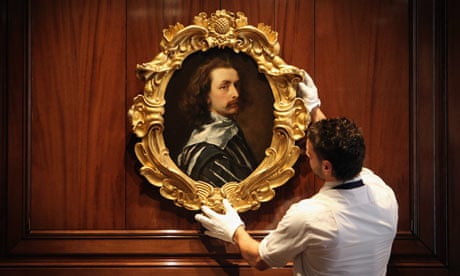Why are really, really rich men so interested in art, beyond that it is expensive. Beauty? Sure, why not. Although, clearly, the pursuit of beauty was only, at best, a runner up to a career making all that dough.
Status, obviously. Competition with other billionaire collectors. Respectability?
Except, expensive art is now a pretty sure sign that you are fast, loose, and overblown, if not corrupt. The world's leading art collector is Steven Cohen, the head of SAC Capital, which the Justice Department has hunted and now cornered in the biggest insider trading scandal ever. After Cohen, many of the other major art buyers are other hedge funders, Russian gangsters, and Chinese billionaires.
Art collector is a new term for vulgarian.
The hedge funder Dan Loeb, billionaire and competitive collector, has now turned his activist investor attention to Sotheby's, buying nearly 10% of the company and seeking to oust its CEO. Cohen, before him, made a grab for Sotheby's too, as have various other financial arrivistes.
The interest in Sotheby's may help explain something about why rich men find art so compelling and about the modern nature of art itself.
Sotheby's has long had one foot in the world of class, manners, and taste, and the other in the new world of the crass, the louche, and the questionable – it's former chairman, Alfred Taubman, the mall mogul and billionaire, once went to jail for price fixing. In a way, Sotheby's has been one of the ways people of lesser standing but greater cash move up in the world. Sotheby's can launder you. You can go into an auction as a nobody and emerge as someone to contend with. Sotheby's sells social cachet.
Rich men are drawn to markets, to the place and method, as well as the general atmosphere and attitude that lets goods and cash meet and be traded. A market's a place of opportunities. And Sotheby's is as much a market as the stock exchange. Adding to its attraction, the Sotheby's marketplace is more controllable than the stock market, and with far less oversight.
Like the stock exchange, it has a further market dynamism because both sides of its transactions are currencies. Like stocks, art, in itself, has come to have an intrinsic and quantifiable value. You turn it into cash only for greater convenience or as a hedge (or, if things go so badly for you that you actually need money). But you could just as well, if you are rich, safely and advantageously move your wealth only among works of art.
Indeed, one of its appeals to the wealthy, and in particular to hedge funders, is that as a currency, art is far more manipulable than most other currencies, save perhaps drugs. If it is not the most corrupt business, art is certainly one of the most loosey-goosey and illogical ones.
At the heart of Loeb's argument with how Sotheby's might more aggressively do its business is his charge that the auction house, which continues to do a substantial business in old and modern masters, does not "fully grasp the central importance of contemporary art to the company's growth, which is highly problematic since these are the categories expanding most rapidly among new collectors".
That is, among new money collectors like himself.
Indeed, it's this anomaly that is, most curiously, at the center of the art business: new work that continues to be produced, of which there is no real limited quantity, and that has no long-term track record of maintaining value, is now worth much more than the work of historic artists with limited availability and demonstrable value. This rather defines an extreme bubble: escalating prices for something of unlimited supply.
Obviously, at least in the short term, Loeb is right. This is a hell of a business: artists, of a certain name and marketing finesse, can essentially print money. Likewise, hedge funders of a certain public finesse seem to be able to print money too. Modern art, of a certain type, and modern investing, of a certain type, are perception plays. Their disruptive presence attains market notice and hence value.
You can hardly do better to reaffirm your status as a fly in the ointment of wealth than make trouble at Sotheby's. You've commanded the attention of the world's vulgarians, and, hence, some of the great pools of money.
From a competitive view, and art is surely a competitive sport, a seat on the Sotheby's board surely couldn't hurt.
In a social sense, that could be worth more than a slew of Damien Hirsts.
Like many hedge fund-type collectors, Loeb's own collection, while full of brand names – Andy Warhol, Jean-Michel Basquiat, Richard Prince, Cindy Sherman, Mike Kelley and Mart Kippenberger, according to the Wall Street Journal – is sniffed at in the art world. He spent a lot, but, in that telling characteristic of the rich, being cheap, he didn't spend enough for the best.
This must be annoying. Not just to be judged on amount but on quality.
So Sotheby's is in a sense a purer play than art itself. It's the art market, which is the sexy and thrilling thing about art.

